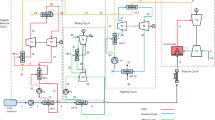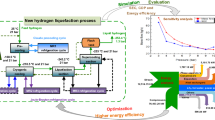Abstract
This study proposed a new cascade liquefaction cycle that uses CO2–C2H6–N2 and CO2–N2, analyzed its performance and exergy using HYSYS which is the liquefaction process simulator, and checked its applicability. The analysis results showed that the CO2–C2H6–N2 liquefaction cycle was more efficient and the CO2–N2 liquefaction cycle was better in terms of exergy loss. Furthermore, the liquefaction cycle that uses the CO2–N2 refrigerant showed lower thermal efficiency and higher compressor work than the conventional liquefaction cycle that uses C3H8–C2H4–C1H4. Thus, the proposed CO2–C2H6–N2 cycle is expected to have reasonably high thermal efficiency and potential for a high liquefaction capacity.







Similar content being viewed by others

Abbreviations
- C1:
-
Methane (–)
- C2:
-
Ethane (–)
- C3:
-
Propane (–)
- C4:
-
Butane (–)
- C3H8 :
-
Propane (–)
- C2H4 :
-
Ethylene (–)
- C2H6 :
-
Ethane (–)
- C1H4 :
-
Methane (–)
- CO2 :
-
Carbon dioxide (–)
- COP:
-
Coefficient of performance (–)
- ex:
-
Exergy rate of refrigerant (MW)
- G:
-
Mass flow rate (kg/s)
- h:
-
Enthalpy (kJ/kg)
- LNG:
-
Liquefied natural gas (–)
- MR:
-
Mixture refrigerant (–)
- NG:
-
Natural gas (–)
- P:
-
Pressure (kPa)
- Qe :
-
Refrigeration capacity (MW)
- s:
-
Entropy (kJ/kgK)
- T:
-
Temperature (°C)
- V:
-
Volume (m3)
- Wc :
-
Compressor work (MW)
- x:
-
Vapor quality (–)
- Δ:
-
Difference (−)
- Eva:
-
Evaporator
- Comp:
-
Compressor
- i:
-
Inlet
- O:
-
Dead-state
- o:
-
Outlet
- m:
-
Middle
- H:
-
High
- L:
-
Low
- n:
-
Number at given state point
References
Yoo SI (2011) A study on cryogenic cascade process for natural gas liquefaction. Pukyong National University, Department of Refrigeration and Air-conditioning Engineering, Thesis for the degree of doctor of philosophy
Andress DL (1996) The Phillips optimized cascade LNG process a quarter century of improvement. The Permission of the Institute of Gas Technology
Kikkawa Y, Nakamura M, Sugiyama S (1997) Development of liquefaction process for natural gas. J Chem Eng Jpn 30:625–630
Roberts MJ, Bronfenbrenner JC, Liu YN, Petrowski JM (2002) Large capacity single train AP-X hybrid LNG process, Gastech Qatar
Yang YM, Lee SG (2009) R&D plan of natural gas liquefaction plant technologies, Proceedings of KIGAS spring conference, pp 229–233
Lee GC, Smith R, Zhu XX (2002) Optimal synthesis of mixed-refrigerant systems for low-temperature processes. Ind Eng Chem Res 41:5016–5028
Paradowski H, Bamba M, Bladanet C (2004) Propane precooling cycles for increased LNG train capacity, 14th international conference and exhibition on liquefied natural gas, pp 107–124
Vaidyaramana S, Maranas C (2002) Synthesis of mixed refrigerant cascade cycles. Chem Eng Commun 189:1057–1078
Cao WS, Lu XS, Lin WS, Gu AZ (2006) Parameter comparison of two small-scale natural gas liquefaction process in skid-mounted packages. Appl Therm Eng 26:898–904
Lee HS, Oh ST, Kim HW, Yoon JI, Yi GB, Lee SG (2009) Analysis of cryogenic refrigeration cycle using two stage intercooler, 5th international conference on diffusion in solids and liquids, pp 40–41
Yoon JI (2013) Effect on heat exchangers efficiency on performance of cryogenic refrigeration cycles. J Korean Soc Power Eng 17:58–63
Gao T, Lin WS, Gu AZ, GU M (2009) Optimization of coalbed methane liquefaction process adopting mixed refrigerant cycle with propane pre-cooling. J Chem Eng Jpn 42:893–901
Oh ST, Choi WJ, Lee HS, Yoon JI, Yoo SI, Choi KH, Lee SG (2010) Optimization of middle pressure and bypass mass flow rate in cryogenic refrigeration cascade cycle. J Korean Soc Power Eng 14:28–33
Yoon JI, Choi WJ, Lee SG, Choi KH, Shim GJ (2013) Efficiency of cascade refrigeration cycle using C3H8, N2O and N2. Heat Transf Eng 34:959–965
Alabdulkarema A, Mortazavi A, Hwang YH, Radermacher R, Rogers P (2011) Optimization of propane pre-cooled mixed refrigerant LNG plant. Appl Therm Eng 31:1091–1098
Hatcher P, Khalilpour R, Abbas A (2012) Optimisation of LNG mixed-refrigerant processes considering operation and design objectives. Comput Chem Eng 41:123–133
Yoon JI, Son CH, Baek SM, Kwag JW, Shim GJ (2012) Efficiency and exergy analysis of new liquefaction cycles applied for LNG FPSO. J Korea Soc Mar Eng 36:574–579
Lemmon EW, Huber ML (2007) NIST reference fluid thermodynamic and transport properties database (REFPROP), Version 8.0, US National Institute of Standards and Technology
Chang HM, Chung MJ, Lee SG, Choi KH (2011) An efficient multi-stage Brayton–JT cycle for liquefaction of natural gas. Cryogenics 51:278–286
Chang HM, Chung MJ, Kim MJ, Park SB (2009) Thermodynamic design of methane liquefaction system based on reversed-Brayton cycle. Cryogenics 49:226–234
Gu AZ, Lu XS, Wang RS (2003) Liquefied natural gas technology. China Machine Press, Beijing
Prausnitz JM, Lichtenthaler RN, De Azevedo EG (1986) Molecular thermodynamics of fluid phase equilibria, 2nd edn. Prentice-HallInc, New Jersey
Mortazavi A, Somers C, Alabdulkarem A, Hwang Y, Radermacher R (2010) Enhancement of APCI cycle efficiency with absorption chillers. Energy 35:3877–3882
Acknowledgments
This work was financially supported by the National R&D project of the “Development of Energy utilization technology with Deep Ocean Water” supported by the Korean Ministry of Land, Transport and Maritime Affairs. We thank Jin-Woo Kwag who helps to submit this paper.
Author information
Authors and Affiliations
Corresponding author
Rights and permissions
About this article
Cite this article
Yoon, JI., Choi, KH., Lee, HS. et al. Assessment of the performance of a natural gas liquefaction cycle using natural refrigerants. Heat Mass Transfer 51, 95–105 (2015). https://doi.org/10.1007/s00231-014-1399-9
Received:
Accepted:
Published:
Issue Date:
DOI: https://doi.org/10.1007/s00231-014-1399-9



